TechnoKontrol-Global Technotelecom
G2/G3/G4 Communication Technologies

TK-Global Technotelecom Mobile Network Telecommunications Projects & Programs
Which are the types of technologies and systems TK-Global Technotelecom offers to our global clients?
A mobile network operator or MNO is a provider of wireless communications services that owns or controls all the elements necessary to sell and deliver services to an end user including radio spectrum allocation, wireless network infrastructure, back haul infrastructure, billing, customer care and provisioning computer systems and marketing, customer care, provisioning and repair organizations.
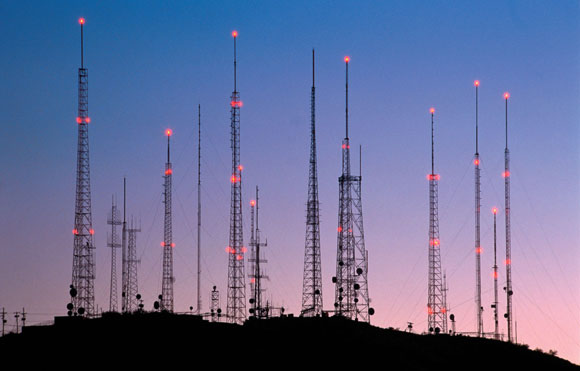
A key defining characteristic of a mobile network operator is that an MNO must own or control access to a radio spectrum license from a regulatory or government entity. A second key defining characteristic of an MNO is that an MNO must own or control the elements of the network infrastructure that are necessary to provide services to subscribers over the licensed spectrum.

A mobile network operator typically also has the necessary provisioning, billing and customer care computer systems and the marketing, customer care and engineering organizations needed to sell, deliver and bill for services, however, an MNO can outsource any of these systems or functions and still be considered a mobile network operator.

Wireless communication is the transfer of information between two or more points that are not connected by an electrical conductor.
The most common wireless technologies use electromagnetic wireless telecommunications, such as radio.
With radio waves distances can be short, such as a few meters for television or as far as thousands or even millions of kilometers for deep-space radio communications.

It encompasses various types of fixed, mobile, and portable applications, including two-way radios, cellular telephones, personal digital assistants (PDAs), and wireless networking.

Other examples of applications of radio wireless technology include GPS units, garage door openers, wireless computer mice, keyboard sand headsets, headphones, radio receivers, satellite television, broadcast television and cordless telephones.

Radio spectrum refers to the part of the electromagnetic spectrum corresponding to radio frequencies – that is, frequencies lower than around 300 GHz (or, equivalently, wavelengths longer than about 1 mm).

TK-GLOBAL TECHNOTELECOM BACKHAUL NETWORKS
In a hierarchical telecommunications network the backhaul portion of the network comprises the intermediate links between the core network, or backbone network and the small sub networks at the "edge" of the entire hierarchical network.

In contracts pertaining to such networks, backhaul is the obligation to carry packets to and from that global network. A non-technical business definition of backhaul is the commercial wholesale bandwidth provider who offers Quality of service (QOS) guarantees to the retailer. It appears most often in telecommunications trade literature in this sense, whereby the backhaul connection is defined not technically but by who operates and manages it, and who takes legal responsibility for the connection or uptime to the Internet or 3G/4G network.

In both the technical and commercial definitions, backhaul generally refers to the side of the network that communicates with the global Internet, paid for at wholesale commercial access rates to or at an Ethernet Exchange or other core network access location. Sometimes middle mile networks exist between the customer's own LAN and those exchanges.

Cell phones communicating with a single cell tower constitute a local sub network, the connection between the cell tower and the rest of the world begins with a backhaul link to the core of the Internet service provider's network. The term backhaul may be used to describe the entire wired part of a network, although some networks have wireless instead of wired backhaul, in whole or in part, for example using microwave bands and mesh network and edge network topologies that may use a high-capacity wireless channel to get packets to the microwave or fiber links.

TK- GLOBAL TECHNOTELECOM CORE NETWORKS SYSTEMS
Visualizing the entire hierarchical network as a human skeleton, the core network would represent the spine, the backhaul links would be the limbs, the edge networks would be the hands and feet, and the individual links within those edge networks would be the fingers and toes.
Other examples include:
- Connecting wireless base stations to the corresponding base station controllers.
- Connecting DSLAMs to the nearest ATM or Ethernet aggregation node.
- Connecting a large company's site to a metro Ethernet network.
- Connecting a submarine communications cable system landing point (which is usually in a remote location) with the main terrestrial telecommunications network of the country that the cable serves.

The choice of backhaul technology must take account of such parameters as capacity, cost, reach, and the need for such resources as frequency spectrum, optical fiber, wiring, or rights of way. Backhaul technologies include:
- FSO Free space optics
- Point-to-point microwave radio relay transmission (terrestrial or, in some cases, by satellite)
- Point-to-multipoint microwave-access technologies, such as LMDS, Wi-Fi, WiMAX, etc., can also function for backhauling purposes
- DSL variants, such as ADSL and SHDSL
- PDH and SDH/SONET interfaces, such as (fractional) E1/T1, E3, T3, STM-1/OC-3, etc.
- Ethernet
- Backhaul capacity can also be leased from another network operator, in which case that other network operator generally selects the technology.
TK-MESH NETWORKS FOR WIRELESS BACKHAUL
As data rates increase, the range of wireless network coverage is reduced, raising investment costs for building infrastructure with access points to cover service areas. Mesh networks are unique enablers that can reduce this cost due to their flexible architecture.

With mesh networking, access points are connected wirelessly and exchange data frames with each other to forward to/from a gateway point. Since a mesh requires no costly cable constructions for its backhaul network, it reduces total investment cost. Mesh technology’s capabilities can boost extending coverage of service areas easily and flexibly.
TK-GLOBAL TECHNOTELECOM DIFFERENT SOLUTIONS FOR EACH CLIENT, REGION AND/OR TECHNICAL REQUIREMENTS.
Many common wireless mesh network hotspots solutions are supported in open source router firmware including DD-WRT, Open WRT and derivatives. Sputnik Agent, Hotspot System, Chillispot and the ad-supported Anchor Free are four examples that work even with lower end routers like the WRT54G.

The IEEE 802.21 standard specifies basic capabilities for such systems including 802.11u unknown user authentication and 802.11s ad hoc wireless mesh networking support. Effectively these allow arbitrary wired net connections to be teamed or ganged into what appears to be a single backhaul - a "virtual private cloud".
Proprietary networks from Meraki follow similar principles.

The use of the term backhaul to describe this type of connectivity may be controversial technically. They invert the business definition, as it is the customer who is providing the connectivity to the open Internet while the vendor is providing authentication and management services.

MOVING FROM WIRELESS BACKHAUL TO WIRED CONNECTIONS
In almost all ways except ease of deployment and ease of moving points of presence, wireless backhaul connections are inferior: They are slower, occupy spectrum that could be used by user devices (especially true as 5.8 GHz devices proliferate), require many more truck rolls as wired backhaul, are limited in capacity, and tend to have significantly worse latency and security than wired networks. They are often viewed as an initial or temporary measure.

TK-Global Technotelecom “Small Cell Signal Booster Telecommunication Innovation Systems & Technologies”.
TK-Global Technotelecom is a pioneer in small cell and femtocell technologies. Unlike other companies, TK-Global Technotelecom has also specialized in other formats as in the most advanced “Small Cells Signal Boosters”, and does not only produce technology at the core network end of a small cell solution, such as gateways and management systems.

This focus has resulted in a unique range of small cell technologies, and it has made it much easier to interoperate with gateway vendors, using open standard interfaces.
Technotelecom has developed a varied range of patented safety, security, law enforcement, military, telecommunications, surveillance technologies and systems that together address all of the novel requirements for a successful commercial deployment of all types of cells including “Small Cell Signal Boosters!:
- Interference – for “Small Cells Signal Boosters” to complement existing networks, they must not cause interference problems, and so must autonomously adapt to changing radio conditions.
- Scale – “Small Cells Signal Boosters” are being deployed in huge numbers, making traditional management methods impossible. “Small Cells Signal Boosters” must be self-managing, making their own decisions based on operator policies.
- High availability – in busy public access environments, “Small Cells Signal Boosters” must be able to meet the service quality KPIs of the macro network without manual engineering intervention.
- Resilience – with minimal manual intervention in set-up and operation, and situated at the end of a commodity backhaul connection, it is essential that “Small Cells Signal Boosters” have the systems to enable self-healing, recovery and upgrade.
- Group behavior – increasingly, mall cells are deployed in groups as self-organizing networks (SON). This extends the utility of “Small Cells Signal Boosters”, but places new demands on their ability to act autonomously.
- Applications – there is a great opportunity to serve and process content at the edge of the network, from inside small cells, where content is closer to mobile users. Specific new technology is required to make this happen.

Why should operators use Active RRM Radios Technologies?
One of several key requirements for operators deploying “Small Sells Signal Boosters” are that they should augment rather than adversely affect the operation and performance of the existing network. In order to achieve this, not only do the cells need to understand their relationship to the macro network on initialization, but they need to be able to adapt to changes as and when they occur.

TK-Global Techotelecom Radio RRM Network benefits.
TK-GLOBAL TECHNOTELECOM RRM Radios delivers the following benefits:
- Automatic identification of 2G, 3G and “Small Cell Signal Boosters” neighbors, technical partners & telecom assets associates via the system.
- Automatic power-setting, tracking systems to optimize coverage, whilst ensuring interference does not exceed levels that are pre-determined by operator policies.
- Automatically adjusts downlink power to that most suitable for the services being used, to minimize interference to nearby macro users.
- Automatic uplink power capping, to ensure “Small Cell Signal Boosters” users do not provide uplink interference to macro cells.
- Automatic data rate adaptation to optimize throughput, whilst responding to interference being experienced and generated by the “Small Cell Signal Boosters”.

TK-GLOBAL TECHNOTELECOM IN EMERGING NATIONS WITH NON/BASIC TELECOMUNICATION TECHNOLOGIES
Mobile operators face increasing customer demand to provide mobile coverage in rural and remote locations. For developing, emerging and developed regions, nations, continents the challenge is to provide national-extensive and even rural, long distance, un-populated based network coverage at an affordable cost, but which makes business sense to deploy.

In the majority of countries as in Africa, South America, coverage is still far from universal, even those that have well-developed networks. In more mature markets, in addition to basic voice coverage, there is now an expectation of mobile data to serve the growing population of smart phones and tablets.

The challenge for all emerging nations telecommunications systems and long distance rural coverage is cost-effectiveness, and in particular the costs of site acquisition, backhaul, power and equipment.
TK-Global Technotelecom technologies and systems including macro-cell coverage tend to be deployed to give as large a coverage area as possible, and a high proportion of users find themselves with relatively viable-operative signal levels but in many cases can find themselves out or range of these a coverage signal areas and thus not having a top level telecommunications system all the time and in all areas or regions.

“Small cell Signal Boosters” solutions have the advantage where they can be used to complement macro national, regional networks. They can be used to extend the overall coverage, either for pockets of population or along highways and railways; or they could be used to provide localized data capacity in locations where it would otherwise not be cost-effective.

The “Small Sells Signal Boosters” themselves are compact devices with low-power consumption, and are installed on existing street furniture or even on residential property, without the need for costly dedicated sites.
To make it easy to understand these systems are like “Small Integrated Signal Boosters”.
TK-Global Technotelecom Operational benefits in using different technologies in different areas with different issues becoming a “Custom made Solution” for our unique client.

Technotelecom emerging nations “Small Cell Booster Solutions” are proven to significantly reduce all of these costs. For backhaul, we use commodity broadband such as DSL, or even low-cost satellites operators anywhere over the globe for maximum coverage backup and coverage at all times and as extensive as possible.
- Field-proven – for reliable high coverage in outdoor-mountain, low level, town, city & rural locations and regions
- Small cell Signal Boosters coverage up to 3km – 16 voice calls, 14.4Mbps HSPA, up to 1W.
- Flexible sitting – multiple backhaul options.
- Provide a high-capacity solution close to the point of use, to match local concentrations of demand.
- Lifecycle management – providing operators complete control of the supply chain, assuring in-service reliability, preserving infrastructure independence and providing a platform for delivering new services.
TK-Global Technotelecom Solution Capabilities
RRM Radio Resource Management
TK-Global Technotelecom has developed unique radio, frequencies, resource algorithms, which mean that the unit(s) explore the radio environment to optimize the service provided to the user, while at the same time minimizing any possible disruption to the external macro network. These algorithms also enable full plug-and-play for the operator, by providing the ability to activate and upgrade “Small Cells Signal Boosters” remotely without affecting service.

Provisioning and automatic setup “Small Cells Signal Boosters” are pre-provisioned with basic configuration parameters so they know who they are and who they belong to. Once plugged in, operator policies are downloaded and the “Small Cells Signal Booster” simply adjust the radio configuration according to local conditions, within the required operational needs. They are then automatically tracked, traced, located and activated in a matter of minutes.

Listen Mode, UL/DL Power Setting. The “Small Cell Signal Booster” contains a downlink Listen Mode, which measures the interference levels of surrounding macro and “Small Cell Signal Boosters’ cells. Using Listen Mode, the Small Cell can select the settings for optimal performance for users of the” Small Cell Booster Systems” while minimizing the interference to the macro according to the operator’s policies, or can be configured by the network operator.
Once installed, the TK-Global Technotelecom “Small Cell Signal Booster Systems” –uniquely – can be configured to continue to monitor the radio environment and adapts to any changes it encounters.
- Dynamic Code and Downlink Power Reallocation. The “Small Cell Signal Booster” supports downlink power reallocation between individual data channels and/or between data channels and HSDPA.
- Downlink Power Adaptation. The “Small Cell Signal Booster’s initially sets its power levels based on the received signal levels it experiences from the macro network, in order to minimize uplink interference, including adjacent channel interference mitigation. These values are then dynamically altered according to the actual levels reported by the end user device through measurement reports.
- Continuous Fast Sniff. The “Small Cell Signal Booster” uniquely uses an active tracking, selection mode during normal operations to monitor changes in the radio environment, without affecting calls. When there are significant changes to the radio environment the addition/removal of a , partner, associate and/or neighboring “Small Cell Signal Booster” will adapt its power levels accordingly.
- Power Tuning. In order to ensure that a hotspot cell is attracting the right level of load, or if the load increases and additional capacity is not yet available, the cell can tune its coverage to maintain optimal throughput in the cell.

TK-Global Technotelecom operational benefits for the end-user/client.
The TK-Global “Small Cell Signal Booster” supports a broad range of call capabilities that meet or exceed mobile operators' needs for subscribers. Equally of importance, all of these capabilities are already used in live commercial networks and, in the process, have been through rigorous testing and optimization cycles.
The system and technology can also be configured to treat voice coverage or data performance preferentially. This suits mobile operators targeting coverage-related market segments, or those who target 3G/4G performance as a selling proposition.
Below is a brief summary of the key call features we support:
- 8-16-Call.
- Video calling support.
- Supplementary Services Support.
- HD voice (WBAMR).
- Emergency Calls.
- HSDPA 14.4 Mbps.
- HSUPA 5.76 Mbps.
- Multiple Primary PDP Contexts.
- Cell FACH.
- Basic Data Rate Adaptation.
- Non-Standard UE Profiling & Corrective Actions.
- Advanced Data Rate Adaptation (Voice priority).
TK-Global Technotelecom Macro Network Interworking Technologies
TK-Global Technotelecom,’ “Small Cell Signal Booster” supports hand out of inter-frequency voice to the 2G (GERAN), and/or 3G macro network and hand out of video calls from the “Small Cell Signal Booster” to the cell to the 3G macro network only. Mobile operators can specify from their management system the priority of the handover type, and who gets the service.
TK-Global Technotelecom “Small Cell Signal Booster” supports the ability for the macro network to perform connected mode handovers of voice calls and data sessions.
Automatic Neighbour List Creation.

The TK-Global Technotelecom “Small Cell Signal Booster” listens for surrounding 2G and 3G cell sites and creates its own list of neighbouring cells, so mobile phones can seamlessly handout to the surrounding macro network without costly manual configuration back in the network.
TK-Global Technotelecom Operational Statistics and Diagnostics
The TK-Global Technotelecom “Small Cell Signal Booster” acts as a part of the mobile network infrastructure, while being an easy to setup and use enterprise device. It is configured and provisioned via a standards-based TR-069/196 management system, and provides alarms and performance data according to a DSL Forum specification (TR-096).
Initial connection and registration with the HMS (HNB Management System) is done securely, and, once operating, the “Small Cell Signal Booster” gathers performance management (PM) data over a period of time, placing it into a performance report.

Technotelecom has developed a highly flexible and comprehensive performance management reporting capability as a result of numerous commercial deployments. For example, the management system has full control over which counters are included in the report and the frequency at which the metrics are collected, and when the reports are started, stopped, and uploaded.
TK-Global Technotelecom Core Network Interfacing, Engine & Gateways
TK-Global Technotelecom “Small Cell Signal Booster Engine” supports up to four different network interface protocols for connection to “Small Cell Signal Booster Gateways”, allowing mobile operators to have the broadest choice of network gateway technologies and suppliers.

TK-Global Technotelecom Universal Mobile Telecommunications System (UMTS)
- InShare
- Comment
- RSS
- A
- AA
- AAA
UMTS (Universal Mobile Telecommunications System) is a so-called "third-generation (3G),"broadband , packet -based transmission of text, digitized voice, video, and multimedia at data rates up to and possibly higher than 2 megabits per second ( Mbps ), offering a consistent set of services to mobile computer and phone users no matter where they are located in the world.

Based on the Global System for Mobile ( GSM ) communication standard, UMTS, endorsed by major standards bodies and manufacturers, is the planned standard for mobile users around the world by 2010. Once UMTS is fully implemented, computer and phone users can be constantly attached to the Internet as they travel and, as they roaming service , have the same set of capabilities no matter where they travel to.
Users will have access through a combination of terrestrial wireless and satellite transmissions. Until UMTS is fully implemented, users can have multi-mode devices that switch to the currently available technology (such as GSM 900 and 1800).
Today's cellular telephone systems are mainly circuit-switched , with connections always dependent on circuit availability. Packet-switched connection, using the Internet Protocol (IP), means that a virtual connection is always available to any other end point in the network.
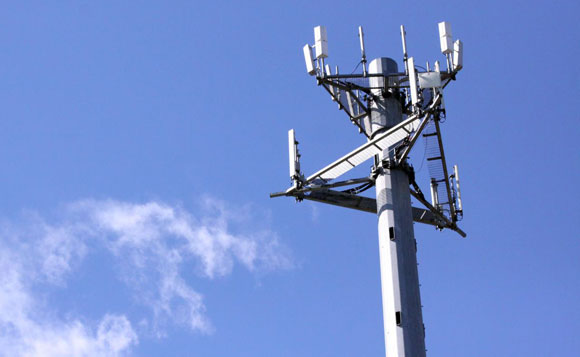
It will also make it possible to provide new services, such as alternative billing methods (pay-per-bit, pay-per-session, flat rate, asymmetric bandwidth, and others).
The higher bandwidth of UMTS also promises new services, such as video conferencing. UMTS promises to realize the Virtual Home Environment (VHE) in which a roaming user can have the same services to which the user is accustomed when at home or in the office, through a combination of transparent terrestrial and satellite connections.
The electromagnetic radiation spectrum for UMTS has been identified as frequency bands 1885-2025 MHz for future IMT-2000 systems, and 1980-2010 MHz and 2170-2200 MHz for the satellite portion of UMTS systems.
UMTS supports maximum theoretical data transfer rates of 42 Mbit/s when HSPA+ is implemented in the network.[2] Users in deployed networks can expect a transfer rate of up to 384 kbit/s for Release '99 (R99) handsets (the original UMTS release), and 7.2 Mbit/s for HSDPA handsets in the downlink connection. These speeds are significantly faster than the 9.6 kbit/s of a single GSM error-corrected circuit switched data channel, multiple 9.6 kbit/s channels in HSCSD and 14.4 kbit/s for CDMA One channel.
Since 2006, UMTS networks in many countries have been or are in the process of being upgraded with High Speed Downlink Packet Access (HSDPA), sometimes known as 3.5G. Currently, HSDPA enables downlink transfer speeds of up to 21 Mbit/s. Work is also progressing on improving the uplink transfer speed with the High-Speed Uplink Packet Access (HSUPA). Longer term, the 3GPP Long Term Evolution (LTE) project plans to move UMTS to 4G speeds of 100 Mbit/s down and 50 Mbit/s up, using a next generation air interface technology based upon orthogonal frequency-division multiplexing.
The first national consumer UMTS networks launched in 2002 with a heavy emphasis on Telco-provided mobile applications such as mobile TV and video calling. The high data speeds of UMTS are now most often utilized for Internet access: experience in Japan and elsewhere has shown that user demand for video calls is not high, and Telco-provided audio/video content has declined in popularity in favour of high-speed access to the World Wide Web—either directly on a handset or connected to a computer via Wi-Fi, Bluetooth or USB.
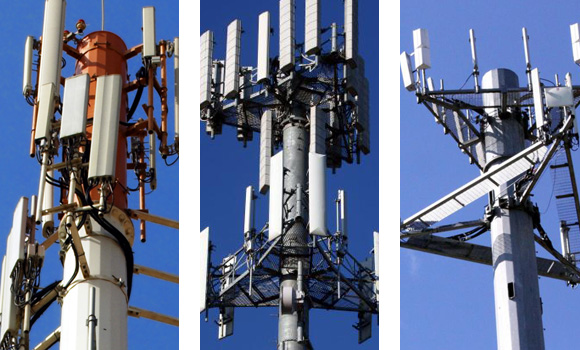
Global Radio Access Network - (UTRAN).
UMTS also specifies the Universal Terrestrial Radio Access Network (UTRAN), which is composed of multiple base stations, possibly using different terrestrial air interface standards and frequency bands.

UMTS and GSM/EDGE can share a Core Network (CN), making UTRAN an alternative radio access network to GERAN (GSM/EDGE RAN), and allowing (mostly) transparent switching between the RANs according to available coverage and service needs. Because of that, UMTS's and GSM/EDGE's radio access networks are sometimes collectively referred to as UTRAN/GERAN.
UMTS networks are often combined with GSM/EDGE, the latter of which is also a part of IMT-2000.

The UE (User Equipment) interface of the RAN (Radio Access Network) primarily consists of RRC (Radio Resource Control), RLC (Radio Link Control) and MAC (Media Access Control) protocols. RRC protocol handles connection establishment, measurements, radio bearer services, security and handover decisions. RLC protocol primarily divides into three Modes—Transparent Mode (TM), Unacknowledged Mode (UM), Acknowledge Mode (AM). The functionality of AM entity resembles TCP operation whereas UM operation resembles UDP operation. In TM mode, data will be sent to lower layers without adding any header to SDU of higher layers. MAC handles the scheduling of data on air interface depending on higher layer (RRC) configured parameters.

The set of properties related to data transmission is called Radio Bearer (RB). This set of properties decides the maximum allowed data in a TTI (Transmission Time Interval). RB includes RLC information and RB mapping. RB mapping decides the mapping between RB<->logical channel<->transport channel. Signaling messages are sent on Signaling Radio Bearers (SRBs) and data packets (either CS or PS) are sent on data RBs. RRC and NAS messages go on SRBs.

Security includes two procedures: integrity and ciphering. Integrity validates the resource of messages and also makes sure that no one (third/unknown party) on the radio interface has modified the messages. Ciphering ensures that no one listens to your data on the air interface. Both integrity and ciphering are applied for SRBs whereas only ciphering is applied for data RBs.
Global Core Networks
With Mobile Application Part, UMTS uses the same core network standard as GSM/EDGE. This allows a simple migration for existing GSM operators. However, the migration path to UMTS is still costly: while much of the core infrastructure is shared with GSM, the cost of obtaining new spectrum licenses and overlaying UMTS at existing towers is high.

The CN can be connected to various backbone networks, such as the Internet or an Integrated Services Digital Network (ISDN) telephone network. UMTS (and GERAN) include the three lowest layers of OSI model. The network layer (OSI 3) includes the Radio Resource Management protocol (RRM) that manages the bearer channels between the mobile terminals and the fixed network, including the handovers.

Spectrum and Signal - Frequencies Allocations
Over 130 licenses have already been awarded to operators worldwide (as of December 2004), specifying W-CDMA radio access technology that builds on GSM.
In Europe, the license process occurred at the tail end of the technology bubble, and the auction mechanisms for allocation set up in some countries resulted in some extremely high prices being paid for the original 2100 MHz licenses, notably in the UK and Germany. In Germany, bidders paid a total €50.8 billion for six licenses, two of which were subsequently abandoned and written off by their purchasers (command the Sonera/Telefonica consortium).

It has been suggested that these huge license fees have the character of a very large tax paid on future income expected many years down the road. In any event, the high prices paid put some European telecom operators close to bankruptcy (most notably KPN).
Over the last few years some operators have written off some or all of the license costs. Between 2007 and 2009 all three Finnish carriers begun to use 900 MHz UMTS in a shared arrangement with its surrounding 2G GSM base stations for rural area coverage, a trend that is expected to expand over Europe in the next 1–3 years.
The 2100 MHz band (downlink around 2100 MHz and uplink around 1900 MHz) allocated for UMTS in Europe and most of Asia is already used in North America. The 1900 MHz range is used for 2G (PCS) services, and 2100 MHz range is used for satellite communications. Regulators have, however, freed up some of the 2100 MHz range for 3G services, together with a different range around 1700 MHz for the uplink.

AT&T Wireless launched UMTS services in the United States by the end of 2004 strictly using the existing 1900 MHz spectrum allocated for 2G PCS services. Cingular acquired AT&T Wireless in 2004 and has since then launched UMTS in select US cities. Cingular renamed itself AT&T Mobility and is rolling out some cities with a UMTS network at 850 MHz to enhance its existing UMTS network at 1900 MHz and now offers subscribers a number of dual-band UMTS 850/1900 phones.
T-Mobile's rollout of UMTS in the US focused on the 1700 MHz band.

In Canada, UMTS coverage is being provided on the 850 MHz and 1900 MHz bands on the Rogers and Bell-Telus networks. Bell and Telus share the network. Recently, new providers Wind Mobile, Mobili city and Videotron have begun operations in the 1700 MHz band.

In 2008, Australian Telco Telstra replaced its existing CDMA network with a national UMTS-based 3G network, branded as NextG, operating in the 850 MHz band. Telstra currently provides UMTS service on this network, and also on the 2100 MHz UMTS network, through a co-ownership of the owning and administrating company 3GIS.
Carriers in South America are now also rolling out 850 MHz networks.

Interoperability and Global Roaming
UMTS phones (and data cards) are highly portable—they have been designed to roam easily onto other UMTS networks (if the providers have roaming agreements in place). In addition, almost all UMTS phones are UMTS/GSM dual-mode devices, so if a UMTS phone travels outside of UMTS coverage during a call the call may be transparently handed off to available GSM coverage. Roaming charges are usually significantly higher than regular usage charges.
Most UMTS licensees consider ubiquitous, transparent global roaming an important issue. To enable a high degree of interoperability, UMTS phones usually support several different frequencies in addition to their GSM fallback. Different countries support different UMTS frequency bands – Europe initially used 2100 MHz while the most carriers in the USA use 850 MHz and 1900 MHz. T-Mobile has launched a network in the US operating at 1700 MHz (uplink) /2100 MHz (downlink), and these bands are also being adopted elsewhere in the Americas.

A UMTS phone and network must support a common frequency to work together. Because of the frequencies used, early models of UMTS phones designated for the United States will likely not be operable elsewhere and vice versa. There are now 11 different frequency combinations used around the world—including frequencies formerly used solely for 2G services.
UMTS phones can use a Universal Subscriber Identity Module, USIM (based on GSM's SIM) and also work (including UMTS services) with GSM SIM cards. This is a global standard of identification, and enables a network to identify and authenticate the (U) SIM in the phone.

Roaming agreements between networks allow for calls to a customer to be redirected to them while roaming and determine the services (and prices) available to the user. In addition to user subscriber information and authentication information, the (U) SIM provides storage space for phone book contact.

Handsets can store their data on their own memory or on the (U) SIM card (which is usually more limited in its phone book contact information). A (U)SIM can be moved to another UMTS or GSM phone, and the phone will take on the user details of the (U) SIM, meaning it is the (U)SIM (not the phone) which determines the phone number of the phone and the billing for calls made from the phone.

Global used Handsets and Modem Systems
All of the major 2G phone manufacturers (that are still in business) are now manufacturers of 3G phones. The early 3G handsets and modems were specific to the frequencies required in their country, which meant they could only roam to other countries on the same 3G frequency (though they can fall back to the older GSM standard). Canada and USA have a common share of frequencies, as do most European countries.

Using a cellular router, PCMCIA or USB card, customers are able to access 3G broadband services, regardless of their choice of computer (such as a tablet PC or a PDA). Some software installs itself from the modem, so that in some cases absolutely no knowledge of technology is required to get online in moments. Using a phone that supports 3G and Bluetooth 2.0, multiple Bluetooth-capable laptops can be connected to the Internet. Some smart phones can also act as a mobile WLAN access point.

There are very few 3G phones or modems available supporting all 3G frequencies (UMTS850/900/1700/1900/2100 MHz). Nokia has recently released a range of phones that have Pentaband 3G coverage, including the N8 and E7. Many other phones are offering more than one band which still enables extensive roaming. For example, Apple's iPhone 4 contains a quadband chipset operating on 850/900/1900/2100 MHz, allowing usage in the majority of countries where UMTS-FDD is deployed.

Black Night Viper - TK Anti EMPS Technologies
TechnoKontrol Anti EMPS Systems - Anti Electromagnetic Pulse Technologies
Nuclear Electromagnetic Pulse (NEMP) / Non Nuclear Electromagnetic Pulse (NNEMP) / Electromagnetic Pulse (EMP) / Protection and Safety Panels-Wall-Textile Technologies for Military and Strategic Infrastructures
TechnoKontrol Anti EMPS Systems - Anti Electromagnetic Pulse Technologies
Nuclear Electromagnetic Pulse (NEMP) / Non Nuclear Electromagnetic Pulse (NNEMP) / Electromagnetic Pulse (EMP) / Protection and Safety Panels-Wall-Textile Technologies for Military and Strategic Infrastructures
Technokontrol has designed via its R&D programme our unique Anti-EMPS technologies which can work in many different sectors for the protection and safety of the military, national security, strategic infrastructures and law enforcement sectors including strategic databases, cyber warfare and information technology bases including satellites, telecommunications, radars,financial services, government databanks and military installations.

Our exclusive, simple to install, transport, and anti-electromagnetic(Anti-EMPS) technology panels/protecting technology products will allow all types of military, strategic, national security departments, private corporations and even civilians to be protected in the event of any type of EMPS attack, from a ground attack by enemy Special Forces, common criminals trying to rob a financial institutions databanks, terrorists to close down a power station or open a dams gates to flood an area or even to bring down aircraft.

Technokontrol Anti-EMPS technology products are effective against EMPS pulses emitted from EMPS bombs/devices which can be delivered in different sizes and means thus not needing to have an extreme technological advanced or unique delivery/launch systems or technologies as a “stealth bomber” or “long range missile launcher” but can be carried in a brief case or even delivered by courier without even knowing of its devastating effects.
Once the EMPS Bomb has been activated which could also include in any mode of transport for example and especially fuel transports systems whom rely on GPS,GMS,satellite technologies as rail, shipping, aircraft and even trucking causing accidents, explosions and full technical failures. Other damages include power shutdowns,environmental damage, loss of life at all levels and even hostage taking at grand level as destroying cruise ships, oil rigs and gas-oil tankers technological control operations centres thus rendering the ships un-controlled and un-directed to their physical sinking/destruction or even causing explosions as engines can be shut down without special cooling off periods or engine burn outs thus causing over-heating of the engines and close down of emergency safety and security systems causing disastrous consequences.
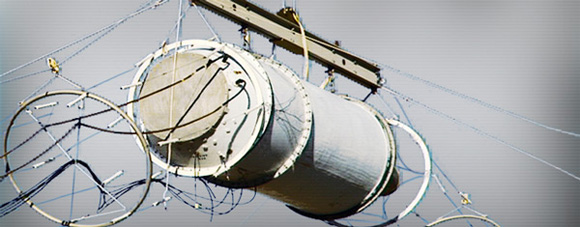
EMP Device
Thus Technokontrol developing different types of specialist alloy “Anti-EMPS Technologies” to be easily installed in low cost effective materials and textiles to allow the quick and wide installation of these "Anti-EMPS Protective Technologies" for and especially for the military and law enforcement but also for the industrial, civilian and industrial-commercial strategic sectors which aren´t as prepared as the military. (Most military modern nations are more prepared than the civilian sector but we still feel that there is much to be done at present and in the near future as assets via EMPS bombings can be easily attacked and destroyed and with the simplest incorrect maintenance or installation errors being also factors to increase the effectiveness of any EMPS attack regardless of “hardening/protecting” of the electronics installed into military operational equipment even at original fabrication level).
As this is and will be a new type of “EMPS Modern Warfare” as with “no energy", there isn´t anything, life, water, food, transport, fuels,telecommunications, medical, police services, government,etc. Thus causing the downfall of the nations society, commerce, industry,government and all types of institutions as we understand it in today´s world.

EMPS warfare technology will make a nation return to the “Middle Ages” in a matter of seconds
This EMPS warfare technology will make a nation return to the “Middle Ages” in a matter of seconds and only will be allowed to be “rebuilt” with the assistance and agreement of the outside world which would normally be its probable “initial enemy-prosecutor” who already caused this destruction for some reason. In a simple conclusion the “damage-explosion” of an EMPS attack will be more of an “social systematic-implosion” against the government or rulers of the effected nation due to the lack of basic human needs as mentioned before and no clear knowledge of an “emergency–recovery” plan which could be viable prepared or in financial wealthly-modern-emerging nations but nil in poor nations or regions or countries controlled by terrorists/criminlas or un-elected/un-stable governments.
EMPS Bombing is by far the most effective way to attack an exact location, region, country but also can be used to “bring down to their knees” any rogue nation, terrorist groups or illegal /occupation/invasion/ wars between regions, states or nations without causing human deaths but allowing as many people to live as possible without any human basic-essential living needs thus destroying the enemies possibility to continue due to not having any electronically operational hardware but also due to the immediate social unrest and auto-implosion-destruction of their own nation due to internal fighting once this occurred due to the lack of supplies, foods, fuels, medicines, etc. Thus allowing wars to be finished in weeks rather than months or years with the total fall of the “enemy”.
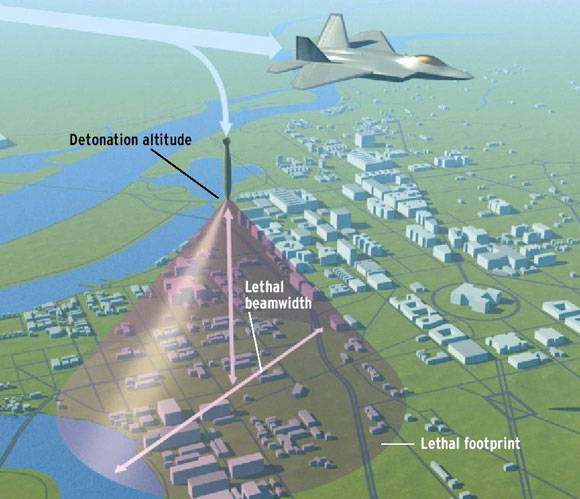
The XXI century is also leading the world to move into a new "Technological Military Era", where human deaths and/or injuries are each time are less and less in each battle-anti terrorism scenario due to the more advanced and high-technology military accurate hardware used in each military or anti-terrorism scenarios are more efective. These new types of technological warfare won´t stop terrorism or sabotage attacks against important national infrastructures as pipelines, refineries, factories, jumbo tanks, rail freight transports, police stations, military bases,etc. This will only increase the spectrum of terror or piracy armament portfolio against normal stable nations, governments or corporations for whatever reason, from economical blackmail to political power control, simple eco-politcial-terrorism or to pure international criminal activities.
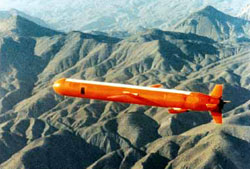
These types of terrorist or piracy attacks which could also include EMPS Bombings if obtained or fabricated by the “other-side” also will have additional national costs which are the financial, industrial, commercial instability at all levels and the worst of all the social and psychological costs of the civilian population which is most cases are nations which are also the voters of these governments of whom are elected to protect these same people/voters. Thus being paramount that as many as possible basic infrastructures operations centres must be protected at all costs in the event of the worst possible scenarios, especially power grids, water resources, telecommunications centres, civil protection, armed forces, government institutions,strategic fuel deposits, fuel delivery services and most importantly food and medical services to the general population.
EMPS Attack technology and its psychological deterrent effect
The psychological effect of a (possible) EMPS attack by any nation/s and its consecuences can be related to other types of social psychological effects(PTSS) for all wars but can be compared in today´s modern day warfare with the example of continuos high-tech military technologies which for an example can be part of any "aerial drone attack programme" may cause over a period of time legal, criminal, punitive liabilities and damages against a government or foreign military manufacturer or supplier due to their direct & indirect psychological, physical and mental damages of normal civilians or habitants of a region, state, country which aren´t at war but effected indirectly due to their physical location.
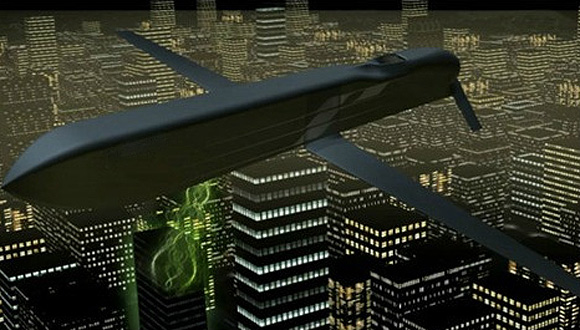
However, these mental stresses as the most common being PTSS also effects the “enforcers or military” thus all parties understanding the value of the psychological warfare effects especially with the use of all types of armaments as IED´s(Improvised Explosive Devices) with the increase of mental issues or illnesses of both sides of the attacked/occupied or territorial controlled civilian/military population as PTSS (Post Traumatic Stress Syndrome) due to the continuous in many cases aggressive military/terrorist attacks on both sides which in many cases may be justified due to harbouring such wanted terrorists-criminals but also in many occasions to impose mental stress to reduce any possible assistance of the local habitants to these terror groups. The contra-effect is then the use of IED´s to continue a never ending battle of will but the pyscological drama of all parties doesn´t stop once back home but only begins with the traumatic psychological battlefield stresses of all parties and for the rest of their lives, especially worse for the modern nations where living standards and human lives are more valuable socially.
This continuous mental stress pressure (PTSS) of the civilian population by means of the above mentioned high-tech strategic warfare methods which includes anyone unrelated or directly,indirectly related due to their political,religious, terrorist causes which in many occasions creates un-necessary deaths, injuries, hardships, psychological mental long term damage/illnesses and even worst a grave regional/national populous "media-backlash", mistrust, hate and longing for revenge which again continues the planting, seeding and growth of a next generation of possible normal civilians to fight against these types of foreign physical, military,social and psychological aggressions/attacks by means of going into terrorist groups or common criminal activities against an established stable government due to past warfare effects or even historical or personal reasons of being invaded or attacked at younger ages and wishing to “pay back” by some way or manner these personal or family damages.

Thus confirming the possible use of this “EMPS Attack Technology” as a final deterrent would resolve many issues immediately or at least swiftly because the consecuences are extremely well understood and all parties will understand that no electronic hardware would work thus sweeping clean an area clean with any telecommunications, economy, transport,electronics, missile launchers, radios, GPS, etc, and stopping the use of “drone bombings-military occupation/controls” and allowing the civilians to continue their lives as normal and as best as possible and to regain their trust. Also by implementing a realistic “re-building civilian programme” with already established selected civilians of that region to benefit from real effective financial, economic,educational, medical assistance to create the right base to grow a new society with normal values but always with a secure and realistic future by means of employment and security.
Not only would the EMPS Attack deterrent would be effective but it will be required as mandatory by all selected nations to create a balance of powers and not allowing this technology to fall into the wrong hands thus having technologies or safety products as manufactured by Technokontrol to protect and to hinder any type of attack from anywhere or anyone for whatever reason.
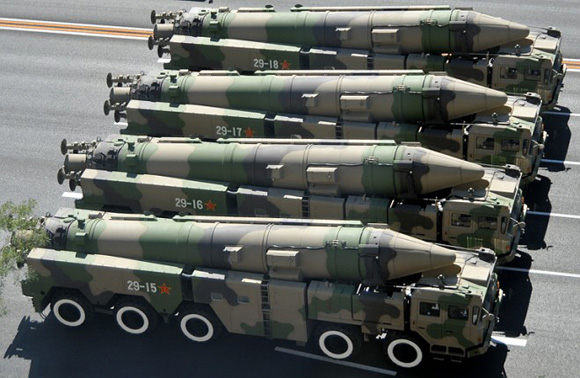
The great savings from financial, logistical,military,social,geo-political using these technologies are extremely important and must be considered as another great positive point towards the production of these EMPS technologies and also the safety-security technologies to protect one owns nation, society, family,etc.
We should consider this technology as such as an important military deterrent as the nuclear aramament which has now been effective for more than seven decades and this could be the new long term safer but more strategic deterrent but will be harder to control as too much data and operational units have been shown as effective from private manufacturers without taking into account all the military technological and financial investment also during the last decades into this technology and even more extreme armament as lazers, etc.
Historical technological creation of EMPS-Cyber Warfare technologies
Due to our belief that modern day warfare is moving into a new direction we believe that new modern military technologies based on pre-WWII technological electromagnetic studies and research technologies mainly invented by the Russians and by the best military German research engineering teams created and effectively tested during 1940-45 having created the first “High Intensity Electromagnetic Electromagnetic Lazer Mobile Artillery Gun in 1944 as a new German Wonder Weapon”, which was the real technological birth place of “electromagnetic armament technology” has been the bases of these new upgraded and developed “Modern Era” type of electronic military battlefield ground-aerial-sea armament of the XXI century.
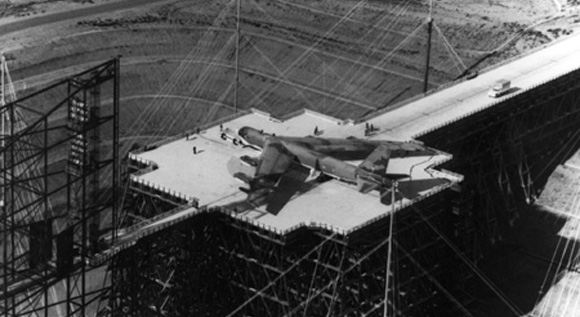
Cyber-war is and has become a real life “virtual battlefield” where governments, private global corporations, financial institutions are presently spending billions of Euros in protecting, preparing, training, anticipating and creating all types of defensive, anti-cyber-attack technology but also contra-offensive or even attack-viral software to hinder, control and to protect these national strategic interests. Who would of thought of modern warefare as todays cyber wars during the 1970´s Vietnam war? This is what will and is occurring with the EMPS technology which may sound un-realistic or even too far into the future in today´s world but will be also a new technological military-defence race but this time we have new comers and not just the “cold war members” but financial criminal economies like the global crime industry which ¡s todays largest global employeer with billions of dollars in disposable assets whom may see this also as a new business venture and without going into global terrorist groups of all backgrounds and political or religuos principles.
This present day cyber war can be understood by how the Iranians have suffered months or even years of continuous delays in their nuclear power program having introduced accidentally by purchasing corrupt technology or deliberately downloading internally viral software by anti-Iranian operatives into their operational technological operations industrial software programs which will never be recognized by any foreign military or nation but it´s obvious that cyber warfare is active and increasing daily from internet fraud, to internet hackers to all types of terrorists. However, this type of war can be done from a basement in New York to a specialist underground military bunker in Asia.
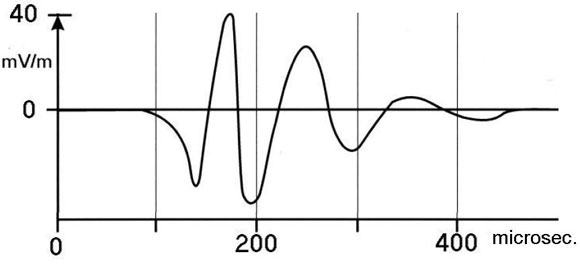
Nuclear test EMP measured 4700 km away 200 kt airburst
This cyber war has also put “against the wall” the strongest governments of the world and to which they have even admitted that extreme sensitive data has been stolen and continues to be stolen from top military USA top secret military and national security databases which are extremely well protected by means of anti-cyber-attack protected technologies and specialist cyber teams. Thus creating a more balanced “battlefield ground” between the top global governments and even small budget, low resourceful terror groups, criminals thus needing in the future to take these terror, criminal groups out at physical ground level or with EMPS bomb technology if required.
Top secret and highly classified sensitive military documents as the technical plans of the new generation USA nuclear submarines are just one example how cyber warfare has been effective by the enemy as these plans were stolen from the USA government by means of cyber attacks. However, we all must be cautious due to many times military officials from all sides stating this loss of information freely in the media can also mean that there is a large part of “dis-information” and sometimes governments wish their enemies to confirm what they already “know” what they have is known to them or to “inform the other party something which may not even exist to make them think in another direction” as pure “dis-information” and this formula is what helped the allies to win WWII more than any direct military attack or battle scenario during the whole campaign as “information” is the difference between losing a war or winning thus the allies being extremely efficient in having their intelligence resources at the right time and at the right place.
EMPS-Electromagnetic Pulse Systems & EMPS types
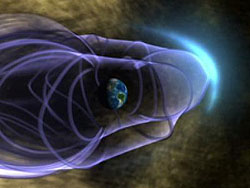
We must state that even though the norm for these types of EMPS can also be created by the solar heat, solar flares, solar radiation, etc. We must then also take into consideration that even though we have prepared our Technokontrol Anti-EMPS Technology for a direct military, criminal or terrorist attack, we also must consider also natural disasters which may also occur at any time without any real firm precision even though scientific studies state that during 2014-2015 the sun solar activity will be at its highest in many years and we have already suffered in some parts of the world these effects as in Ottawa, Canada and in Australia where the solar radiation brought down many electronic base services.
Even in most related data to solar radiation may be very precise no one can really predict anything 100% when we can´t even forecast the weather in the next three to five days, how can us humans predict a solar flare or radiation sometime in the near future or ever. We must also understand that only several degrees of temperature increase or decrease at global level can be disastrous for the human population, natural and all living species and we mustn’t forget our recent “five century long XIV-XIX centuries” of the so called "little ice age" which left the world in a precarious natural and human situation so if this to where to occur the other way round and a “little hot age" things could be possibly even worse due to our present modern needs of technology and electronics for anything in our daily lives.
Technical data regarding types of EMP: EMP1, EMP2 and EMP3
EMP- TYPE E1-Nuclear EMPS
The EMP1 pulse is the very fast component of nuclear EMP. The EMP1 component is a very brief but intense electromagnetic field that can quickly induce very high voltages in electrical conductors. The EMP1 component causes most of its damage by causing electrical breakdown voltages to be exceeded. EMP1 is the component that can destroy computers and communications equipment and it changes too quickly for ordinary lightning protectors to provide effective protection against it.
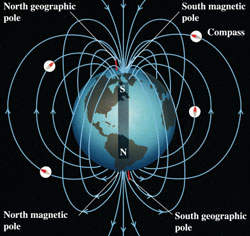
The Earth's magnetic field quickly deflects the electrons at right angles to the geomagnetic field, and the extent of the deflection depends upon the strength of the magnetic field. At geomagnetic field strengths typical of the central United States, central Europe or Australia, these initial electrons spiral around the magnetic field lines in a circle with a typical radius of about 85 metres (about 280 feet). These initial electrons are stopped by collisions with other air molecules at an average distance of about 170 metres (a little less than 580 feet). This means that most of the electrons are stopped by collisions with air molecules before they can complete one full circle of its spiral around the Earth's magnetic field lines.
This interaction of the very rapidly-moving negatively-charged electrons with the magnetic field radiates a pulse of electromagnetic energy. The pulse typically rises to its peak value in about 5 nanoseconds. The magnitude of this pulse typically decays to half of its peak value within 200 nanoseconds. (By the IEC definition, this EMP1 pulse is ended at one microsecond (1000 nanoseconds) after it begins.) This process occurs simultaneously with about 1025 other electrons.
There are a number of secondary collisions which cause the subsequent electrons to lose energy before they reach ground level. The electrons generated by these subsequent collisions have such reduced energy that they do not contribute significantly to the EMP1 pulse.
These 2 MeV gamma rays will normally produce an EMP1 pulse near ground level at moderately high latitudes that peaks at about 50,000 volts per metre. This is a peak power density of 6.6 megawatts per square metre.
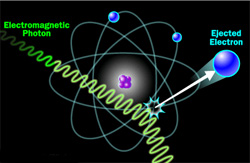
The process of the gamma rays knocking electrons out of the atoms in the mid-stratosphere causes this region of the atmosphere to become an electrical conductor due to ionization, a process which blocks the production of further electromagnetic signals and causes the field strength to saturate at about 50,000 volts per metre. The strength of the EMP1 pulse depends upon the number and intensity of the gamma rays produced by the weapon and upon the rapidity of the gamma ray burst from the weapon. The strength of the EMP1 pulse is also somewhat dependent upon the altitude of the detonation.
There are reports of "super-EMP" nuclear weapons that are able to overcome the 50,000 volt per metre limit by the very nearly instantaneous release of a burst of gamma radiation of much higher energy levels than are known to be produced by second generation nuclear weapons. The reality and possible construction details of these weapons are classified, and therefore cannot be confirmed by scientists in the open scientific literature.
EMP-TYPE EMP2- NNEMP-Non Nuclear EMP
The EMP2 component is generated by scattered gamma rays and inelastic gammas produced by weapon neutrons. This EMP2 component is an "intermediate time" pulse that, by the IEC definition, lasts from about 1 microsecond to 1 second after the beginning of the electromagnetic pulse. The EMP2 component of the pulse has many similarities to the electromagnetic pulses produced by lightning, although the electromagnetic pulse induced by a nearby lightning strike may be considerably larger than the EMP2 component of a nuclear EMP. Because of the similarities to lightning-caused pulses and the widespread use of lightning protection technology, the EMP2 pulse is generally considered to be the easiest to protect against.
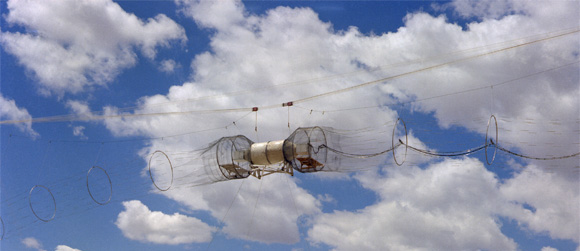
According to the United States EMP Commission, the main potential problem with the EMP2 component is the fact that it immediately follows the EMP1 component, which may have damaged the devices that would normally protect against EMP2.
According to the EMP Commission Executive Report of 2004, "In general, it would not be an issue for critical infrastructure systems since they have existing protective measures for defence against occasional lightning strikes. The most significant risk is synergistic, because the EMP2 component follows a small fraction of a second after the first component's insult, which has the ability to impair or destroy many protective and control features. The energy associated with the second component thus may be allowed to pass into and damage systems.
EMP-TYPE EMP3-Solar EMP
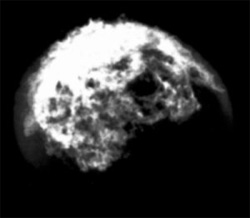
The EMP3 component is very different from the other two major components of nuclear EMP. The EMP3 component of the pulse is a very slow pulse, lasting tens to hundreds of seconds, that is caused by the nuclear detonation heaving the Earth's magnetic field out of the way, followed by the restoration of the magnetic field to its natural place. The EMP3 component has similarities to a geomagnetic storm caused by a very severe solar flare.[Like a geomagnetic storm, EMP3 can produce geo-magnetically induced currents in long electrical conductors, which can then damage components such as power line transformers.
Because of the similarity between solar-induced geomagnetic storms and nuclear EMP3, it has become common to refer to solar-induced geomagnetic storms as "solar EMP."[At ground level, however, "solar EMP" is not known to produce an EMP1 or EMP2 component.
Types and sizes of present and future EMP Bombs
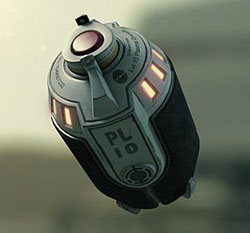
There are at present proof of small EMPS attack weapons which emit short, high-energy pulses reaching 10 gigawatts, which could destroy complex electronics systems. This EMPS bomb attacks systems can now already presently take out electronic systems of nuclear or electric power plants, banks, trains, or even a simple telephone switchboard. These systems can be carried in boxes, suitcases, briefcases, computer bags, etc.
Any type of EMPS attack from a thermonuclear warhead to a solar flare would cause ionospheric radiation and electronic effects to any national or international region, territory or nations. Once these issues and greater understanding of these new types of armaments were confirmed and the consequences understood most military computers and electronic systems were "prepared/protected" to minimize such damage, but civil systems remain extremely vulnerable.
There are mainly two types of non-nuclear EMP (NNEMP) and one main nuclear High Altitude HEMP devices which have been developed since the Vietnam War mainly. One uses conventional explosives to induce the EMP; another uses a single-use, high-power microwave generation device.
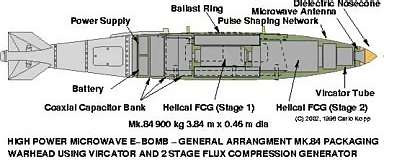
These smaller versions of EMPS Bomb/Explosive Systems can be used by Special Forces teams who infiltrate the enemy's and detonate a device near their electronic devices. It destroys the electronics of all computer and communication systems in a quite large area. The EMP bomb can be smaller than a HERF gun to cause a similar amount of damage and is typically used to damage not a single target (not aiming in one direction) but to damage all equipment near the bomb.
The efficient execution of an Information Warfare campaign against a modern industrial or post-industrial opponent will require the use of specialized tools designed to destroy information systems. High Power Electro-magnetic Pulse generation techniques and High Power Microwave technology have matured to the point where practical electro-magnetic bombs are becoming technically feasible, with new applications in both Strategic and Tactical IW (Information Warfare).
Targets of the EMPS-bombs:
- The telecommunication systems
- The national power grid
- Finance and banking systems
- The national transporting systems
- The mass media
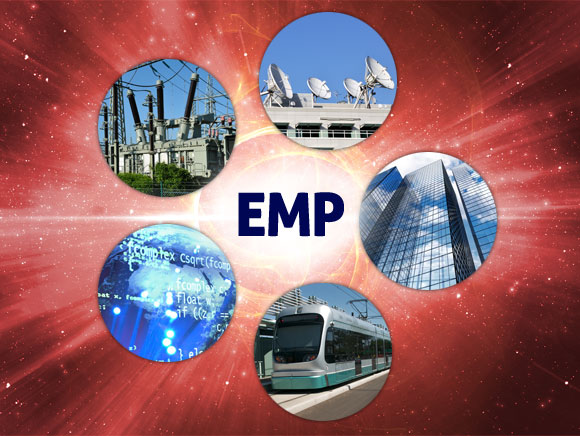
EMP Targets
A Radio Frequency Weapon is one that uses intense pulses of RF energy to destroy or degrade the electronics in a target. These weapons can be employed in a narrow beam over a long distance to a point target. They are categorized as High Power Microwave Weapons (HPM) and Ultra Wide Band Weapon (UWB). The phrase non-nuclear electro-magnetic pulse is sometimes used.
Advantages of the HPM:
- All weather
- Low cost per engagement
- Possible to engage multiple targets
- Non-lethal to humans
- Not able to detect attacks
What can Electro-magnetic EMPS do to a nation or attacked location?

The high temperatures and energetic radiation produced by nuclear explosions also produce large amounts of ionized (electrically charged) matter which is present immediately after the explosion. Under the right conditions, intense currents and electro-magnetic fields can be produced, generically called EMP (Electro-magnetic Pulse), that are felt at long distances. Living organisms are impervious to these effects, but electrical and electronic equipment can be temporarily or permanently disabled by them. Ionized gases can also block short wavelength radio and radar signals (fireball blackout) for extended periods.
The occurrence of EMP is strongly dependent on the altitude of burst. It can be significant for surface or low altitude bursts (below 4,000 m); it is very significant for high altitude bursts (above 30,000 m); but it is not significant for altitudes between these extremes. This is because EMP is generated by the asymmetric absorption of instantaneous gamma rays produced by the explosion. At intermediate altitudes the air absorbs these rays fairly uniformly and does not generate long range electro-magnetic disturbances.
The formation EMP begins with the very intense, but very short burst of gamma rays caused by the nuclear reactions in the bomb. About 0.3% of the bomb's energy is in this pulse, but it last for only 10 nanoseconds or so. These gamma rays collide with electrons in air molecules, and eject the electrons at high energies through a process called Compton scattering. These energetic electrons in turn knock other electrons loose, and create a cascade effect that produces some 30,000 electrons for every original gamma ray.
In low altitude explosions the electrons, being very light, move much more quickly than the ionized atoms they are removed from and diffuse away from the region where they are formed. This creates a very strong electric field which peaks in intensity to 10 nanoseconds. The gamma rays emitted downward however are absorbed by the ground which prevents charge separation from occurring.
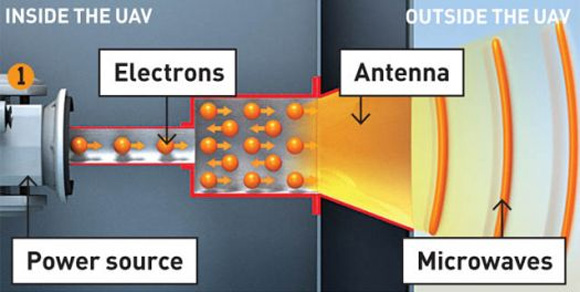
This creates a very strong vertical electric current which generates intense electro-magnetic emissions over a wide frequency range (up to 100 MHZ) that emanate mostly horizontally. At the same time, the earth acts as a conductor allowing the electrons to flow back toward the burst point where the positive ions are concentrated. This produces a strong magnetic field along the ground. Although only about 3x10^-10 of the total explosion energy is radiated as EMP in a ground burst (10^6 joules for 1 Mt bomb), it is concentrated in a very short pulse. The charge separation persists for only a few tens of microseconds, making the emission power some 100 gigawatts. The field strengths for ground bursts are high only in the immediate vicinity of the explosion. For smaller bombs they aren't very important because they are strong only where the destruction is intense anyway. With increasing yields, they reach farther from the zone of intense destruction. With a 1 Mt bomb, they remain significant out to the 2 psi overpressure zone (5 miles).
High altitude explosions produce EMPs that dramatically more destructive. About 3x10^-5 of the bomb's total energy goes into EMP in this case, 10^11 joules for a 1 Mt bomb. EMP is formed in high altitude explosions when the downwardly directed gamma rays encounter denser layers of air below. A pancake shaped ionization region is formed below the bomb. The zone can extend all the way to the horizon, to 2500 km for an explosion at an altitude of 500 km. The ionization zone is up to 80 km thick at the center. The Earth's magnetic field causes the electrons in this layer to spiral as they travel, creating a powerful downward directed electro-magnetic pulse lasting a few microseconds. A strong vertical electrical field (20-50 KV/m) is also generated between the Earth's surface and the ionized layer, this field lasts for several minutes until the electrons are recaptured by the air. Although the peak EMP field strengths from high altitude bursts are only 1-10% as intense as the peak ground burst fields, they are nearly constant over the entire Earth's surface under the ionized region.
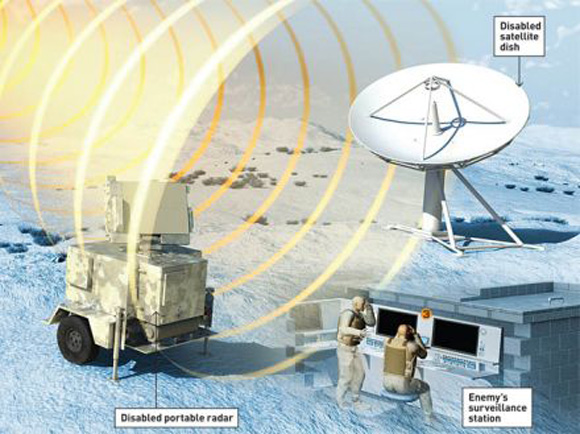
The effects of these field on electronics is difficult to predict, but can be profound. Enormous induced electric currents are generated in wires, antennas, and metal objects (like missiles, airplanes, and building frames). Commercial electrical grids are immense EMP antennas and would be subjected to voltage surges far exceeding those created by lightning, and over vastly greater areas. Modern VLSI chips are extremely sensitive to voltage surges, and would be burned out by even small leakage currents. Military equipment is generally designed to be resistant to EMP, but realistic tests are very difficult to perform and EMP protection rests on attention to detail. Minor changes in design, incorrect maintenance procedures, poorly fitting parts, loose debris, moisture, and ordinary dirt can all cause elaborate EMP protections to be totally circumvented. It can be expected that a single high yield, high altitude explosion over an industrialized area would cause massive disruption for an indeterminable period, and would cause huge economic damages (all those damaged chips add up).
What is a Fireball Blackout? How can it block Radar Systems?
A separate effect is the ability of the ionized fireball to block radio and radar signals. Like EMP, this effect becomes important with high altitude bursts. Fireball blackout can cause radar to be blocked for tens of seconds to minutes over an area tens of kilometers across. High frequency radio can be disrupted over hundreds to thousands of kilometers for minutes to hours depending on exact conditions.

The technology base for EMPS-bombs
Explosively Pumped Flux Compression Generators (FCG)
The central idea behind the construction of FCGs is that of using a fast explosive to rapidly compress a magnetic field, transferring much energy from the explosive into the magnetic field. The initial magnetic field in the FCG prior to explosive initiation is produced by a start current. The start current is supplied by an external source, such a high voltage capacitor bank (Marx bank), a smaller FCG or the MHD device. A number of geometrical configurations for FCGs have been published. The most commonly used arrangement is that of the coaxial FCG.
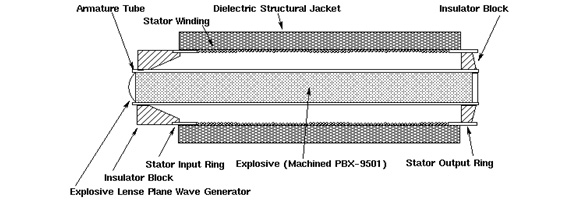
The coaxial arrangement is of particular interest in this context, as its essentially cylindrical form factor lends itself to packaging into munitions. In principle, any device capable of producing a pulse of electrical current of the order of tens of kilo Amperes to Mega Amperes will be suitable.
Explosive and Propellant driven MHD Generators
The fundamental principle behind the design of MHD devices is that a conductor moving through a magnetic field will produce an electrical current transverse to the direction of the field and the conductor motion. In an explosive or propellant driven MHD device, the conductor is a plasma of ionized explosive or propellant gas, which travels through the magnetic field. Current is collected by electrodes which are in contact with the plasma jet. The electrical properties of the plasma are optimized by seeding the explosive or propellant with suitable additives, which ionize during the burn.
High Power Microwave Sources (Vircator)
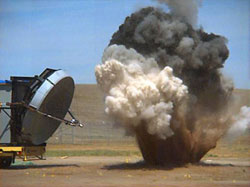
The fundamental idea behind the Vircator is that of accelerating a high current electron beam against a mesh (or foil) anode. Many electrons will pass through the anode, forming a bubble of space charge behind the anode. Under the proper conditions, this space charge region will oscillate at microwave frequencies. If the space charge region is placed into a resonant cavity which is appropriately tuned, very high peak powers may be achieved.
Coupling modes
The major problem area in determining lethality is that of coupling efficiency, which is a measure of how much power is transferred from the field produced by the weapon into the target.
Front door coupling occurs typically when power from an electro-magnetic weapon is coupled into an antenna associated with radar or communications equipment. The antenna subsystem is designed to couple power in and out of the equipment.
Back Door Coupling occurs when the electro-magnetic field from a weapon produces large transient currents or electrical standing waves (when produced by a HPM weapon) on fixed electrical wiring and cables interconnecting equipment, or providing connections to mains power or the telephone network.
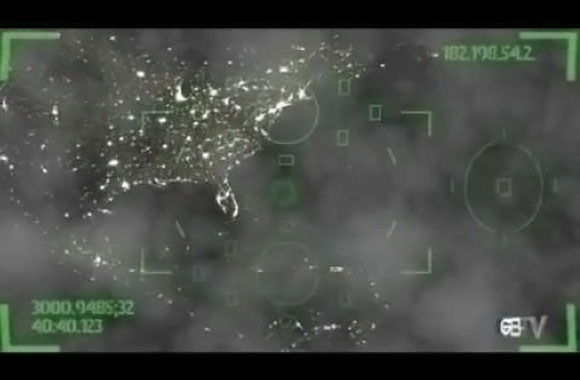
A low frequency bomb built around an FCG will require a large antenna to provide good coupling of power from the weapon into the surrounding environment. Whilst weapons built this way are inherently wide band, as most of the power produced lies in the frequency band below 1 MHz compact antennas are not an option.
Microwave bombs have a broader range of coupling modes and given the small wavelength in comparison with bomb dimensions, can be readily focussed against targets with a compact antenna assembly.
The importance of glide-bombs as delivery means for HPM warheads is threefold. Firstly, the glide-bomb can be released from outside effective radius of target air defences, therefore minimizing the risk to the launch aircraft. Secondly, the large standoff range means that the aircraft can remain well clear of the bomb's effects. Finally the bomb's autopilot may be programmed to shape the terminal trajectory of the weapon, such that a target may be engaged from the most suitable altitude and aspect.
Targeting Electro-Magnetic Bombs
The task of identifying targets for attack with electro-magnetic bombs can be complex. Certain categories of target will be very easy to identify and engage. Buildings housing government offices and thus computer equipment, production facilities, military bases and known radar sites and communications nodes are all targets which can be readily identified through conventional photographic, satellite, imaging radar, electronic reconnaissance and humint operations. These targets are typically geographically fixed and thus may be attacked providing that the aircraft can penetrate to weapon release range. With the accuracy inherent in GPS/inertially guided weapons, the electro-magnetic bomb can be programmed to detonate at the optimal position to inflict a maximum of electrical damage.

Mobile and camouflaged targets which radiate overtly can also be readily engaged. Mobile and relocatable air defence equipment, mobile communications nodes and naval vessels are all good examples of this category of target. While radiating, their positions can be precisely tracked with suitable Electronic Support Measures (ESM) and Emitter Locating Systems (ELS) carried either by the launch platform or a remote surveillance platform. In the latter instance target coordinates can be continuously data-linked to the launch platform. As most such targets move relatively slowly, they are unlikely to escape the footprint of the electro-magnetic bomb during the weapon's flight time.
Mobile or hidden targets which do not overtly radiate may present a problem, particularly should conventional means of targeting be employed. A technical solution to this problem does however exist, for many types of target. This solution is the detection and tracking of Unintentional Emission (UE). UE has attracted most attention in the context of TEMPEST surveillance, where transient emanations leaking out from equipment due poor shielding can be detected and in many instances demodulated to recover useful intelligence. Termed Van Eck radiation, such emissions can only be suppressed by rigorous shielding and emission control techniques, such as are employed in TEMPEST rated equipment.

Whilst the demodulation of UE can be a technically difficult task to perform well, in the context of targeting electro-magnetic bombs this problem does not arise. To target such an emitter for attack requires only the ability to identify the type of emission and thus target type, and to isolate its position with sufficient accuracy to deliver the bomb. Because the emissions from computer monitors, peripherals, processor equipment, switch-mode power supplies, electrical motors, internal combustion engine ignition systems, variable duty cycle electrical power controllers (thyristor or triac based), super-heterodyne receiver local oscillators and computer networking cables are all distinct in their frequencies and modulations, a suitable Emitter Locating System can be designed to detect, identify and track such sources of emission.
A good precedent for this targeting paradigm exists. During the SEA (Vietnam) conflict the United States Air Force (USAF) operated a number of night inter-diction gun-ships which used direction finding receivers to track the emissions from vehicle ignition systems. Once a truck was identified and tracked, the gun-ship would engage it.
Because UE occurs at relatively low power levels, the use of this detection method prior to the outbreak of hostilities can be difficult, as it may be necessary to over-fly hostile territory to find signals of usable intensity. The use of stealthy reconnaissance aircraft or long range, stealthy Unmanned Aerial Vehicles (UAV) may be required. The latter also raises the possibility of autonomous electro-magnetic warhead armed expendable UAVs, fitted with appropriate homing receivers. These would be programmed to loiter in a target area until a suitable emitter is detected, upon which the UAV would home in and expend itself against the target.
Technokontrol Anti-EMPS Defence against EMPS-bombs and EMPS personal carried device attacks.
The most effective defence against electro-magnetic bombs is to prevent their delivery by destroying the launch platform or delivery vehicle, as is the case with nuclear weapons. This however may not always be possible, and therefore systems which can be expected to suffer exposure to the electro-magnetic weapons effects must be electro-magnetically hardened.

The most effective method is to wholly contain the equipment in an electrically conductive enclosure; Technokontrol has developed the Anti-EMPS Protection Panels for such protection systems termed a Faraday cages or TK-EMPS Panel Protected Bunker-Buildings, which prevents the electro-magnetic field from gaining access to the protected equipment. However, most such equipment must communicate with and be fed with power from the outside world, and this can provide entry points via which electrical transients may enter the enclosure and effect damage. While optical fibers address this requirement for transferring data in and out, electrical power feeds remain an on-going vulnerability. The use of these protective systems with our own electromagnetic power supply as the TK-Omega RF5000 and TK-Orion RF5000 will also not to need to require external energy supply thus closing down all and any leaks thus allowing the base or bunker totally EMPS protected and anti EMPS attack proof.
Where an electrically conductive channel must enter the enclosure, electro-magnetic arresting devices must be fitted. A range of devices exist, however care must be taken in determining their parameters to ensure that they can deal with the rise time and strength of electrical transients produced by electro-magnetic devices. Reports from the US indicate that hardening measures attuned to the behaviour of nuclear EMP bombs do not perform well when dealing with some conventional microwave electro-magnetic device designs. Thus needing to use Technokontrols Anti-EMPS Protection Technology which as being simple and effective will not need to be applied to the internal electronics of any of the devices required for protection as the whole area, zone, section will be protected for all outside EMPS and thus needing to install an antenna to continue to operate with the outside world once the danger has been overcome or passed allowing normal operations to continue if desired.
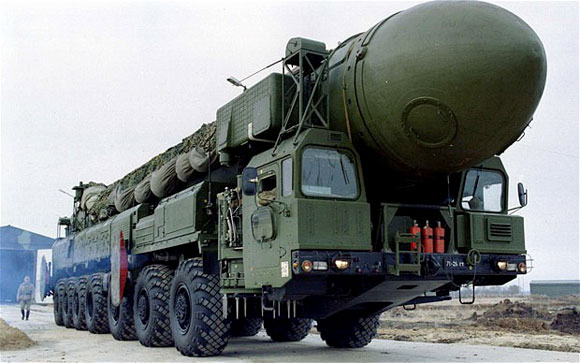
Technokontrol Anti-EMPS Protection Panels will save any military, government or corporation to do significant “hardening/protecting” of their systems, as electro-magnetic damage to any single element of a complex system could inhibit the function of the whole system. Hardening new build equipment and systems will add a substantial cost burden. Older equipment and systems may be impossible to harden properly and may require complete replacement. In simple terms, hardening by design is significantly easier than attempting to harden existing equipment. Thus using Technokontrol Anti-EMPS technology will avoid mass change-over investments and allowing all electronics to continue their normal operations reducing cost, time, burden and protecting classified data, locations or confidential interests to outside operators.
Intermittent faults may not be possible to repair economically, thereby causing equipment in this state to be removed from service permanently, with considerable loss in maintenance hours during damage diagnosis. This factor must also be considered when assessing the hardness of equipment against electro-magnetic attack, as partial or incomplete hardening may in this fashion cause more difficulties than it would solve. Indeed, shielding which is incomplete may resonate when excited by radiation and thus contribute to damage inflicted upon the equipment contained within it.

Electromagnetic damage to any single element of a complex system could inhibit the function of the whole system.
Other than hardening against attack, facilities which are concealed should not radiate readily detectable emissions. Where radio frequency communications must be used, low probability of intercept (i.e... spread spectrum) techniques should be employed exclusively to preclude the use of site emissions for electro-magnetic targeting purposes. Appropriate suppression of UE is also mandatory.
EMPS Weapons
Complex and expensive experimental efforts are more timely and cost-effective if they are tested by theoretical and computational modelling. Such computations are made tractable by viewing the device as a system consisting of a pulsed power source, microwave source, and an antenna.
Electro-magnetic bombs are Weapons of Electronical Mass Destruction with applications across a broad spectrum of targets, spanning both the strategic and tactical. As such their use offers a very high payoff in attacking the fundamental information processing and communication facilities of a target system. The massed application of these weapons will produce substantial paralysis in any target system, thus providing a decisive advantage in the conduct of Electronic Combat, Offensive Counter Air and Strategic Air Attack.

Because EMPS-bombs can cause hard electrical kills over larger areas than conventional explosive weapons of similar mass, they offer substantial economies in force size for a given level of inflicted damage, and are thus a potent force multiplier for appropriate target sets.
What will happen if we don´t anticipate this new modern day technological threat? Why must TechnoKontrol Anti-Electromagnetic EMPS technology should be used?
Electro-magnetic bombs are Weapons of Electronical Mass Destruction with applications across a broad spectrum of targets, spanning both the strategic and tactical. As such their use offers a very high payoff in attacking the fundamental information processing and communication facilities of a target system. The massed application of these weapons will produce substantial paralysis in any target system, thus providing a decisive advantage in the conduct of Electronic Combat, Offensive Counter Air and Strategic Air Attack.
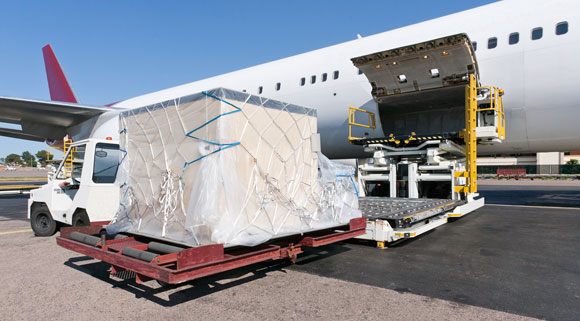
EMPS-bombs can cause hard electrical kills over larger areas than conventional explosive weapons of similar mass, they offer substantial economies in force size for a given level of inflicted damage, and are thus a potent force multiplier for appropriate target sets.
The non-lethal nature of electro-magnetic weapons makes their use far less politically damaging than that of conventional munitions, and therefore broadens the range of military options available.

EMPS-bombs can be an affordable force multiplier for military forces which are under financial and economic pressures to reduce force sizes, increasing both their combat potential and political utility in resolving disputes. Given the potentially high payoff deriving from the use of these devices, it is incumbent upon such military forces to appreciate both the offensive and defensive implications of this technology. It is also incumbent upon governments and private industry to consider the implications of the proliferation of this technology, and take measures to safeguard their vital assets from possible future attack.
All governments, armed forces, corporations, business people, civilians and society in general should be aware of this mass destructive technology and which at present has no indication to be stopped due to not needing extremely difficult minerals or chemicals or top global engineers or research teams to be created once it basics can be copied and developed. No one can also predict what the “Sun-EMP3” will do tomorrow as a simple point of view and that isn´t even taking into account the use of this EMPS technology in the hands of the wrong people with the wrong reasons.

What are our governments going to do to resolve this issue or at least to protect the population and nation in general if the worst came to the worst scenario? What are the emergency plans? Which bases will be protected?Whom will be selected to be protected and why? Who will protect our families in the case of civil un-rest, lack of food, electricity, transport, etc?
These are questions which must be answered today for tomorrow and a well planned security and safety plan must be put into place and in advance and at least thought, programmed and designed by any modern day nation with their national strategic and global interests at heart as their nations representatives to overcome this extremely viable and pragmatic near future threat from criminals, terrorists to state enemies or from natures natural wishes as solar radiation.
Thus needing Technokontrol's Anti-EMPS Protetection Technology as soon as possible in all strategic installations at least for the civilian protection and most importantly at military and government levels.

U.S. military definition of Electromagnetic Radiation Hazards (RADHAZ or EMR) in relation to Electromagnetic Pulses/Radiation/Solar-Space Electromagnetic Radiation(EMPS)
In Federal Standard 1037C, the United States government adopts the following definition:
Electromagnetic radiation hazards (RADHAZ or EMR hazards)
Hazards caused by a transmitter/antenna installation that generates electromagnetic radiation in the vicinity of ordnance, personnel, or fueling operations in excess of established safe levels or increases the existing levels to a hazardous level; or a personnel, fueling, or ordnance installation located in an area that is illuminated by electromagnetic radiation at a level that is hazardous to the planned operations or occupancy.
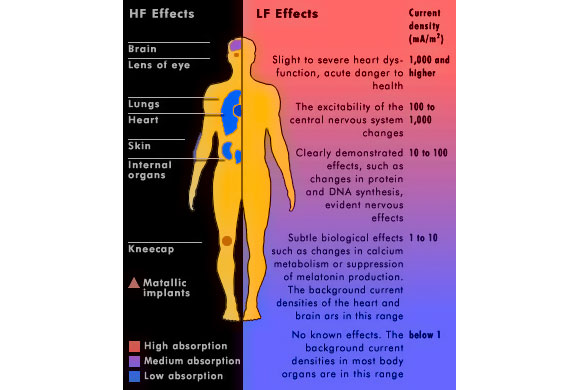
These hazards will exist when an electromagnetic field of sufficient intensity is generated to: (a) induce or otherwise couple currents or voltages large enough to initiate electro-explosive devices or other sensitive explosive components of weapon systems, ordnance, or explosive devices; (b) cause harmful or injurious effects to humans and wildlife; (c) create sparks having sufficient magnitude to ignite flammable mixtures of materials that must be handled in the affected area. —Department of Defense Dictionary of Military and Associated Terms.
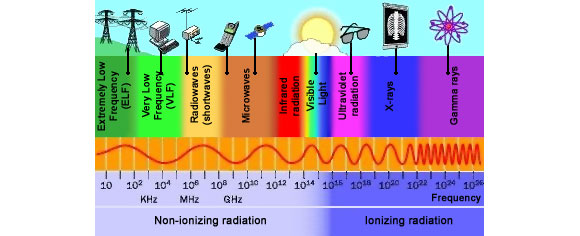
The Department of Defense Dictionary of Military and Associated Terms is a compendium of terminology used by the United States Department of Defense (DOD). It sets forth standard US military and associated terminology to encompass the joint activity of the Armed Forces of the United States in both US joint and allied joint operations, as well as to encompass the Department of Defense (DOD) as a whole. These military and associated terms, together with their definitions, constitute approved DOD terminology for general use by all components of the Department of Defense. The Secretary of Defense, by DOD Directive 5025.12, 22 August 1989, Standardization of Military and Associated Terminology, has directed its use throughout the Department of Defense to ensure standardization of military and associated terminology to those who need to know. The G-A-22 Group of Angelic Alliance to the United States and all who are members of any and all {United States Military, Defense and any and all Police known or unknown are protected.
Military Satellite Data Systems
The Satellite Data System (SDS) is a system of United States military communications satellites. At least three generations have been used: SDS-1 from 1976 to 1987; SDS-2 from 1989 to 1996; SDS-3 from 1998 to the present. SDS satellites have a highly elliptical orbit, going from about 300 kilometers at perigee to roughly 39,000 km at apogee in order to allow communications with polar stations that cannot contact geo synchronous satellites.

The high apogee meant that the polar regions were visible for long amounts of time, and only two satellites were required in order to achieve constant communications ability. In addition, two geostationary satellites appear to be part of the system. The SDS satellites were constructed by Hughes Aircraft.

The primary purpose of the SDS satellites is to relay imagery from low-flying reconnaissance satellites, notably the Keyhole optic reconnaissance and Lacrosse/Onyx radar reconnaissance satellites to ground stations in the United States.

Each SDS-1 satellite had 12 channels available for ultra-high frequency communication. They were cylindrical in shape, roughly 25 feet (7.6 m) long. 980 watts of electrical power were available from solar panels and batteries. The SDS-1 had a mass of 1385 pounds (630 kilograms) and was launched on Titan-3B rockets. The SDS-1 satellites had similar orbits to the Air Force's Jumpseat ELINT satellites.

The SDS-2 is significantly more massive at 5150 pounds (2335 kg), with three separate communication dishes, including one for a K band downlink. Two dishes are 15 feet (4.5 meters) in diameter, while the third is 6.6 feet (2 m) in diameter. The solar arrays generate 1238 watts of power. It is believed that the Space Shuttle has been used to launch several satellites, possibly on missions STS-28, STS-38, and STS-53. Other launches have used the Titan-4 rocket.

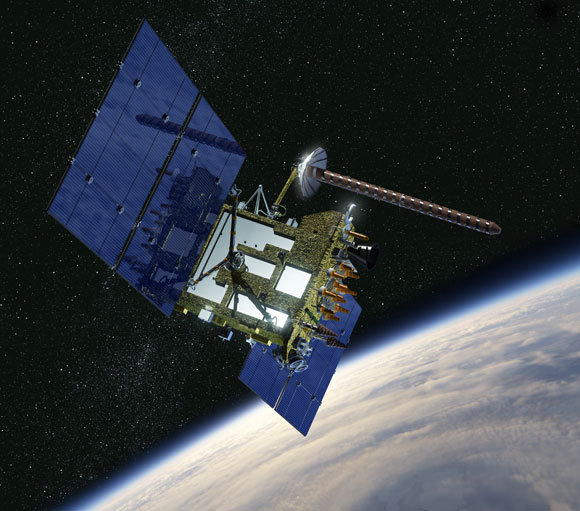
Technokontrol Certificates & Associations
Technokontrol Manufactures, Designs & Researches our safety products in the European Union at the highest possible International Accident,Health & Safety standards.
TechnoKontrol is a member of the NFPA

TechnoKontrol Products are ATEX Compliant
(European Antiexplosive Safety Directives)

Technokontrol's Products & Services are insured by

Certificates



































Company Sections
- The Corporation
- Company Introduction
- Mission Statement
- Our Team
- Our Plant
- Product Presentation
- TK-Global Engineering
- TK-Global Electronics
- TK-Global Environment
- TK-Global Technotelecom
- TK-Corporate Governance
- TK-Emergency Call Center
Commitment to Quality
TechnoKontrol Wikipedia

TechnoKontrol: 1st in Spain for own Technology patents 2013 & 2014

- Ministerio de Industria Turismo y Comercio-OEPM
Technokontrol, the number 1 corporation in Spain filing for its own technology patents, trademarks and utility patents (SPA) - OEPM 2013 The year in numbers (SPA)
TechnoKontrol has been fully verified and certified by Bureau Veritas

Certificates
- ISO 9001 - ES108784-1
- ISO 14001 - ES108782-1
- ISO 45001 - ES108783-1
- ISO 4126
- ISO 28000
- ISO 37000

NFPA-National Fire Protection Association
NFPA-Asociación Nacional de Protección contra el fuego
TechnoKontrol is a member of the NFPA

NFPA 69: Standard on Explosion Prevention Systems, 2016 Edition
Prevent deflagration explosions due to combustible dust particles, gases or vapors with NFPA 69. Combustible dust, gases and vapors produced in industrial settings can pose a significant safety hazard.NFPA 69: Standard on Explosion Prevention Systems offers definitive guidance on explosion protection and prevention systems.
ATEX - European Antiexplosive Safety Directives

- ATEX Guide: Protection in explosive atmospheres
- ATEX-EU/HAZLOZ-USA/NFPA-USA/DSEAR-UK/Explosion Directives TechnoKontrol Additional Anti-Explosion Data
- ATEX Directive in EU Directives
Dangerous Substances and Explosive Atmospheres Regulations - United Kingdom/ATEX

United Nations Economic Commission for Europe - UNECE - TechnoKontrol

- TechnoKontrol information for the UNECE BLEVE working group
Proposal transmitted by the governments of Spain and France
The European Parliament and The Council

Technokontrol's Products & Services are insured by

Dossiers TK Group of Companies
TK-Global Engineering


More info
Should you want to receive more information, please contact us.
